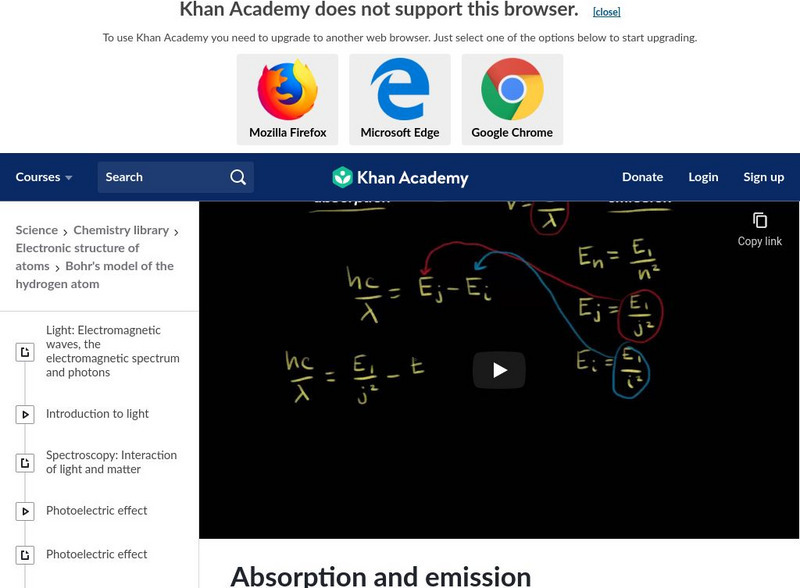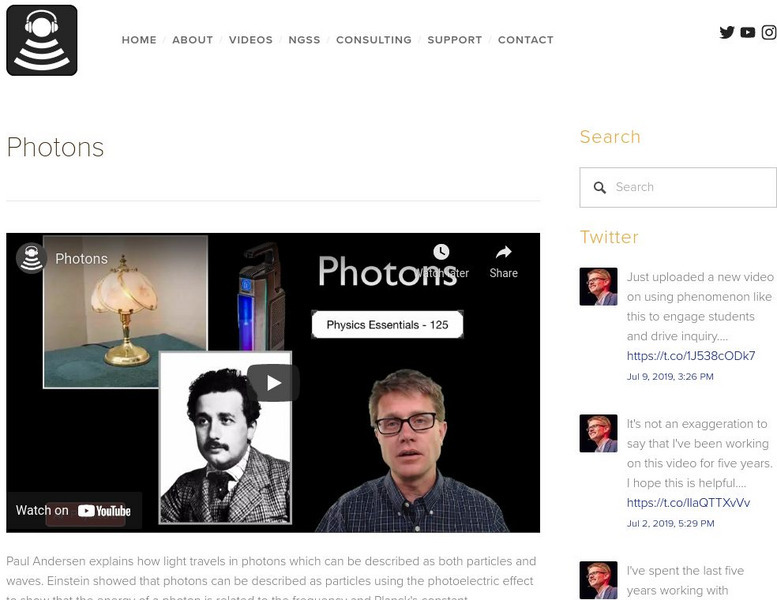SciShow
Tractor Beams: Almost Real!
Tractor beams attract an object from a distance and were first proposed in a science fiction novel published in 1931. A video explains how current tractor beams work, what they are able to move, and the limitations of moving things. It...
SciShow
Great Minds: Richard Feynman, The Great Explainer
Who is known for his bongo playing and solving the hardest algebra problem of all time? Richard Feynman loved to solve puzzles and didn't handle being bored very well. He is known for the Feynman diagrams that explain quantum...
Be Smart
The Cosmic Afterglow
A short video explains one piece of research that supports the Big Bang Theory. The discovery of the sound of radiation from the photons during the creation of our universe is a sound we all recognize as static, but we often...
Berkeley University of California
Photoelectrons
How much energy does it take for an electron jump from chromium metal? Using a formula, the instructor describes the procedure for determining the wavelength of light needed for a specific metal to eject electrons.
Berkeley University of California
Photoelectric Effect-Tennis Ball
Different light has different energy! An informative video describes the photoelectric effect by describing the result of different wavelengths of light hitting metal. The instructor describes the threshold of releasing electrons as...
Berkeley University of California
Light Intensity-Geiger Counter
Light can be broken down into particles similar to atoms! The instructor in the video uses a thought experiment to describe the process of breaking down light into particles and introduces the energy of a photon formula. He then uses a...
TED-Ed
How Do Solar Panels Work?
What are those shiny things that people are installing on the roofs of their houses? Learn about the structure, function, and logistics of solar panels, as well as the challenges of using the sun's energy as our exclusive power source on...
TED-Ed
How to Detect a Supernova
While a star explodes every second or so in the observable universe, we can't observe a supernova in its first moments. Discover the fascinating science behind how astronomers and physicists are attempting to detect supernovas early...
TED-Ed
Sunlight Is Way Older than You Think
Light travels fast... really fast. But that doesn't mean it moves instantly from its source to whatever object it hits. After watching this video students will understand that once generated in the sun's core,...
TED-Ed
Particles and Waves: The Central Mystery of Quantum Mechanics
Help young physicists make a quantum leap in their understanding of matter with this short instructional video. Tracing the early work of Max Planck, Albert Einstein, and others, this resource explains the science behind the...
MinutePhysics
How to Break the Speed of Light
Have you ever wanted to break the speed of light from your backyard? Something seemingly impossible, and technically improbable, looks impressive thanks to the "magic" of science. The brief video explains how photons can travel from your...
Curated OER
The Universe - Secrets of The Sun 2/5
Where did our sun come from? Scientists believe that the sun and our solar system was born from a supernova. Part two of this five-part series explains the sun's plasma, magnetic field, sunlight, and something called flux ropes. This is...
Curated OER
Photosynthesis Presentation
This collection of animated slides offers an explanation of the photosynthesis process. It must be homemade as the sounds of dishes clanging, a television commercial, and computer mouse clicks are heard in the background. You will need...
PBS
Pbs Learning Media: Light and Color
This video segment adapted from Shedding Light on Science illustrates the dispersion of light through a prism and how raindrops refract sunlight to form rainbows. [3:55]
Khan Academy
Khan Academy: Absorption and Emission
An explanation of the absorption and emission of energy using shell models. [10:30]
Khan Academy
Khan Academy: Photosynthesis: Calvin Cycle
Video lesson studies the Calvin Cycle, or the light-independent (dark) reactions of photosynthesis. [13:27]
Khan Academy
Khan Academy: Photosynthesis: Overview of the Light Dependent Reactions
Video lecture focuses on light-dependent reactions that use photons from the sun and includes the structure of the chloroplast, the photosystems, and how ATP is synthesized. [20:15]
PBS
Pbs Learning Media: The Electromagnetic Spectrum: Nasa
From radio waves to gamma rays, this video segment from NASA introduces the seven categories of the electromagnetic spectrum and how each type of radiation is part of our everyday lives. [2:58]
PBS
Pbs Learning Media: Tour of the Electromagnetic Spectrum: Radio Waves
A tour of radio waves in the electromagnetic spectrum. [3:38]
University of Nottingham
Sixty Symbols: Symbols of Physics and Astronomy: Photons
Physicists and astronomers have different views of photons, what they are, and how they behave. Watch as three University of Nottingham scientists discuss the nature of photons and why the study of light is important. [8:32]
Bozeman Science
Bozeman Science: Photons
In the following video Paul Andersen explains how light travels in photons which can be described as both particles and waves. Einstein showed that photons can be described as particles using the photoelectric effect to show that the...
Khan Academy
Khan Academy: Light and Fundamental Forces: Introduction to Light
Provides an introduction to light and the electromagnetic spectrum, and how light behaves as both a wave and a particle. [9:36]
Other
Vimeo: Matter and Atoms
Looks at the history of atomic theory and ideas about atomic models that have evolved over time. Covers models put forward by John Dalton, J.J. Thomson, Earnest Rutherford, Niels Bohr, and the work of Schrodinger and Heisenberg. Also...
Science Friday Initiative
Science Friday: Is It Possible to Make Matter From Light?
Revisiting a theory from 1934, scientists are investigating whether it is possible to develop a photon-photon collider which theoretically could convert light into matter. Aired May 23, 2014 [11:50 min]





















